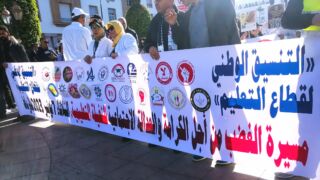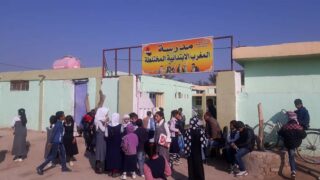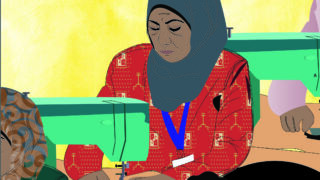
This publication has benefited from the support of the Rosa Luxemburg Foundation. This text may be reproduced in part or in full, provided the source is acknowledged.
Morocco, which has, for a long time, chased after the dream of King Hassan II to become part of the European Community, found itself facing its African reality and the consequences of its geographical location, which not only gives it one sole view on the European continent but also makes it the broadest African portal to Europe… However, Morocco’s aspirations seem to be shared by many others. Many dreamers take a trouble they believe is worth pursuing, thinking that the 14 kilometers that separate Morocco from the “other side” are not impossible to cross, only to discover that distance doesn’t really matter that much. They also find out that the hardships of the long distance marathon they had run to arrive to this point are nothing compared to the crossing of the few remaining kilometers safeguarded by an impenetrable barrier.
Some migrants are adamant on crossing at all costs, taken by the arduous journey they have gone through and their closeness to the arrival point, while others chose to remain there for some time. If those who stay manage to get a residence permit, it would save them from much trouble if they are caught afterwards in a European country, as their repatriation will be to the country of residence, Morocco, and not to their countries of origin… This way, they can try again, with less effort.
A winter and summer journey
Issa sits on the “Meagazine” fence (its name means “fence of the workless”) in Tangiers, facing his European dream beyond the sea ahead of him. Only 14 kilometers separate him from his dream, which is the same distance that separates him from where he came from in the depth of the African continent. When he decided to leave everything behind and jump into the unknown towards the North of the continent, he didn’t know that the journey would be this difficult or that the road to heaven would be paved by so many hardships.
The lucky ones among the migrants take a bus, the others patch the road on their feet, determined to walk forward no matter how bumpy or precarious it gets, or how uncertain its end might be.
Some become adamant on crossing at all costs, taken by the arduous journey they have gone through and their closeness to the destination point, while others choose to remain in Morocco for some time. If these manage to get a residence permit, it would save them from much trouble if they are caught in a European country, as their repatriation will be to the country of residence, Morocco, instead of their countries of origin…
Some migrants are adamant on crossing at all costs, taken by the arduous journey they have gone through and their closeness to the arrival point, while others chose to remain there for some time. If those who stay manage to get a residence permit, it would save them from much trouble if they are caught afterwards in a European country, as their repatriation will be to the country of residence, Morocco, and not to their countries of origin… This way, they can try again, with less effort.
Issa’s two-week journey took him from Mali, through Algeria and finally to Morocco, where he arrived on his feet. He shared the road with dozens of others. After reaching Morocco, the last point on the continent that he wants to leave, Issa discovered that before the long-awaited crossing, his life could be improved if he first gets a residence permit. He could bargain time while waiting for an opportunity to migrate as, when you have nothing but time, you spend it generously.
On these trips, the suffering of women is multiplied. They go through sexual exploitation, which often comes from fellow travelers whose sexual instincts are not deterred by the severe conditions and the total deprivation, and who would resort to violence when their female counterparts refuse them. Many of the women arrive with a round belly and irreparable psychological wounds. Sometimes, exploitation comes from others who happen to cross their road during their summer and winter journeys.
Difficulties and attempts to integrate
After arriving to Morocco, migrants have to travel other distances from the east to the north of the country where they will be able to cross towards Europe. There, they scatter in the woods, far from the policemen’s sight. Living out on the plain, they merely manage to survive, setting up tents out of reeds, cartons and plastic bags or sleeping in unused sewer tunnels… In other cases, they head straight to the big coastal cities, which brings them closer to their migration point. They are usually housed in small apartments, rented by friends or family members who have already obtained legal residence. Dozens of bodies crumple in few meters in no decent living conditions. They eat whatever they have gathered from the waste containers, or what is given to them by charitable people or, like Issa does, they carry boxes for the greengrocer in exchange of some vegetables. They all live without any kind of healthcare.
In Tangiers, where migration is deemed possible, you would find migrants of all ages but mostly young people, even though some are over forty. The majority is men, yet there is an augmentation of the number of women who, in their miserable conditions, give birth and care for children. The secret migrants who give birth in Morocco, can obtain a residence permit more easily and the policemen bother them less when they are pregnant. The newborns sometimes become a device that might be used for begging.
The suffering of women is multiplied. They go through sexual exploitation, which often comes from fellow travelers whose sexual instincts are not deterred by the severe conditions and the total deprivation, and who would resort to violence when their female counterparts refuse them. Many of the women arrive with a round belly and irreparable psychological wounds. Sometimes, exploitation comes from others who happen to cross their road during their summer and winter journeys.
The police agents go after migrants, cram them into trucks and push them to the border. The population doesn’t accept them well, and observes them with apprehension. Fatima from Guinea-Bissau, says “even the children harass us”.
The situation of sub-Saharan migrants in Morocco raises questions for those who don’t manage to cross the Sea and who are an increasing majority. How do they integrate into the Moroccan society which is not used to host foreigners in difficult conditions? How will the Moroccan state and its social and administrative institutions treat them? The Moroccan society, despite its openness, has mostly welcomed wealthy Europeans in the past decades, rich Arabs, or Syrians in difficult conditions who are not looked at with skepticism as they share with Moroccans the same religion and a physical resemblance.
Despite the coexistence in the Moroccan society, there are broad categories of racists in it. The sub-Saharans who own nothing are seen as an additional burden. The Moroccans who consider themselves veterans of the migration-related issues, know that most of those migrants will fail at crossing the Mediterranean Sea and stay there as they cannot go back to their countries of origin. This reality is difficult to accept for the Moroccans, particularly because it becomes combined with the countless socioeconomic problems they face.
Some of those migrants manage to find a little job that allows them to provide for the bare necessities. It usually ranges between “selling counterfeit jewelry by installments” and manual labor whenever they find someone who agrees to employ them. The graduates or those who have migrated legally manage to find real work in the big cities where the society is more likely to embrace foreigners.
“Mon ami” (French for “my friend”) is how Moroccans address sub-Saharan migrants when they talk to them. While the migrants call all the Moroccan men “Mohammad” and the women “Fatima” or “hejja”. Those among them who practice beggary, have a recurrent preferred phrase, “As-salaam-alaikum hejja – or Fatima or Mohammad – a dirham please, for God’s sake”, and this is often all they know in Arabic. Most of the migrant women who have kids choose strategic points and practice beggary with their children in their hands while conversing among each other. They request charity with a low voice, almost inaudible, as if the fact that they are foreign women in a distant country were sufficient to indicate their need for charity.
Invent what you can’t find
When you have nothing to lose or gain but your life, you become creative and adventurous and accept whatever opportunity comes your way. Many sub-Saharan migrants have taken the path of beggary but lots of them have tried to explore other ways to earn their livelihood, either because they have stayed longer than expected or because beggary was not sufficient to start anew or because their pride stood in the way of this practice.
This is how migrants came to invent new professions, such as cleaning alleys and neighborhoods, in exchange for small amounts of money required from the inhabitants after the task is completed. They also sell African clothes on the street or place a small bench in a popular market to propose forged accessories to a network specific to Africans. Others do African hairstyles in women’s esthetic salons located in neighborhoods where many legal sub-Saharans reside, or at the corners of markets. Sometimes they offer all the possible beauty services in the street, like a manicure for cheap prices (50 dirhams for example, when it costs 150 dirhams in other salons). Some others work as car-minders in the streets after having gradually integrated into the Moroccan society.
Staying in groups to integrate
Because it is difficult to integrate in the Moroccan society, sub-Saharan migrants stay together and move together. The ones who came to Morocco to study or work are able to better integrate and are more accepted by the Moroccan society. The latter opens up its doors to irregular migrants from their countries of origin and allows them to stay and benefit from the stable conditions in marginal neighborhoods where apartment owners go easy on them. This becomes totally impossible in the downtowns, to the point that apartment owners often forbid sub-Saharan migrants to even receive visitors. Therefore, sub-Saharan migrants (both regular and irregular) find in agglomerating in certain neighborhoods a way to create a possible life and a compensation for the difficulty to integrate by creating their own miniature African society.
In Tangiers, the Boukhalef neighborhood, next to the Faculty of Law, has the advantage of being both distant from downtown and a place where many African students reside. With time, the number of African residents has increased until they constituted half of the inhabitants of the district, either legally through renting or illegally by occupying empty apartments whose owners had left for certain reasons, only to find them overcrowded with migrants once they get back. This neighborhood has one of the largest sub-Saharan migrant populations in Morocco and has become famous especially after violent incidents occurred among the migrant population and between migrants and the local population.
In return for Morocco’s protection of the European borders through tightening control, Morocco receives important financial assistance. In 2013, the country launched a “national strategy for migration and asylum” which enabled around 23 thousand migrants to regularize their situation and which developed in 2016.
One of the solutions that sub-Saharan migrants have resorted to, is to seek refuge in the churches which have become less empty with their presence, especially on Sundays. There, they meet and share experiences and advices and receive food and clothes aid which are gathered for this purpose on Mondays and Thursdays. They have also managed to establish a cultural club and a weekly musical festival in the “Villa de France” hotel, famous for inspiring Matisse’s painting “Window at Tangiers”.
Fraternity
Lately, Morocco has gone back to its African roots after having, for a long time, aspired to the European horizon. Therefore, the sub-Saharan migration to Morocco is not only related to its geographical proximity to Europe but is also linked with the exponentially growing number of Africans residing in the country, principally students who benefit from scholarships allocated to them by the Moroccan government in the framework of partnerships with their countries of origin. They numbered almost 16 thousand students in 2017. This was further reinforced by the new steps taken by the Moroccan Ministry of Health, which included the recruitment of Senegalese doctors to overcome the lack of doctors in some remote areas in the South of the country, because of the reluctance of Moroccan doctors to fill the vacant posts. 32 posts remain vacant to this day in these regions because of the difficult climate and the limited infrastructure. The Ministry has started with twenty doctors, and if the attempt succeeds in the Tata region in the South of Morocco, it will be followed by further recruitments of doctors from Senegal, Ivory Coast and other countries, to fulfill the needs of these remote areas.
Interim adjustment
Transforming migration into a Moroccan problem is a situation that benefits the African migrant, Europe and Morocco (on a short term, as on a longer term the country has the most to lose). The residence permit allows the migrant who manages to cross to Europe to return to Morocco if expulsed. In return for Morocco’s protection of the European borders through tightening control, Morocco receives substantial financial assistance. Bilateral agreements, such as the one between Morocco and Spain, makes it host the migrants arrested in Spain which subjects the country to more economic, social and security problems.
In November 2013, the country launched a “national strategy for migration and asylum”. This strategy includes programs to facilitate the integration of migrants in Morocco in the educational system, to guarantee their access to treatment in Moroccan hospitals, to grant them the right to housing according to the Moroccan laws, to offer them juridical and humanitarian assistance, to facilitate their access to vocational trainings, in addition to fighting human trafficking and combatting human smugglers. And indeed, around 23 thousand irregular migrants benefitted from the program before it was stopped in 2016. This operation included granting residence permits for one year, later extended to three.
According to the Office of the High Commissioner for Refugees (UNHCR) in Morocco, the “national strategy for migration and asylum” was successful after the fourth year of its launching, at least for migrants, as it guaranteed their physical and juridical protection. The number of migrants registered with the UNHCR in Morocco reaches 5 thousand who have the right to health, work and education (82% of the children are registered in public schools).
Though, the attempts to cross to Europe persist. And because this crossing has become almost impossible, migrants resort to embarking on rudimentary boats, on rubber boats or even to swimming or sneaking aboard cargo trucks in the port of Tangiers. Only a few of them reach the imagined heaven.
The content of this publication is the sole responsibility of Assafir Al-Arabi and Rosa Luxemburg Foundation cannot accept any liability for it.
Translated from Arabic by Fourate Chahal Rekaby
Published in Assafir Al-Arabi on 12/08/2018






